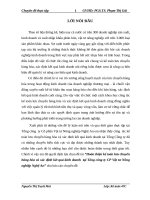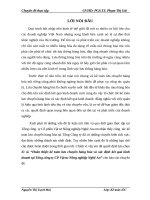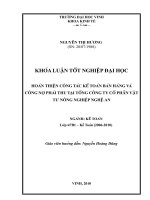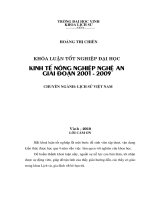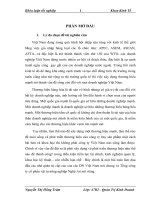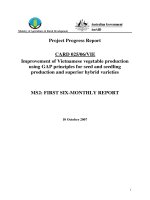Dự án nông nghiệp " Nghe An Province Sustainable Village Based Beef Cattle Development, Training and Extension Programme " MS5 docx
Bạn đang xem bản rút gọn của tài liệu. Xem và tải ngay bản đầy đủ của tài liệu tại đây (40.08 KB, 8 trang )
Ministry of Agriculture & Rural Development
010/06VIE:
Nghe An Province
Sustainable Village Based Beef Cattle
Development, Training and Extension
Programme
Project Progress Report
MS5: THIRD SIX-MONTHLY REPORT
August 2008
1
Table of Contents
1 Institute Information 2
2 Project Abstract 3
3 Executive Summary 3
4 Progress to Date 4
Implementation Highlights 4
Smallholder Benefits 4
Capacity Building 5
Publicity 5
Project Management 5
5 Report on Cross-Cutting Issues 6
6 Implementation & Sustainability Issues 6
Issues and Constraints 6
Intervention Options 6
Sustainability 6
7 Next Critical Steps 7
8 Statutory Declaration Error! Bookmark not defined.
2
1 Institute Information
Project Name
Nghe An Province, sustainable village based
beef cattle development, training and
extension project.
Vietnamese Institution
19 May Fruit & Vegetable Co; and Bavi
Cattle and Forage Research Centre
Vietnamese Project Team Leader
Mr Nguyen Duc Diep
Australian Organisation
AusAID
Australian Personnel
Mr Tim Harvey
Date commenced
February 2007
Completion date (original)
December 2009
Completion date (revised)
-
Reporting period
Six month Intervals
Contact Officer(s)
In New Zealand: Team Leader
Name:
Mr Tim Harvey
Telephone:
00 64 6 350 5119
Position:
Director
Fax:
00 64 6 350 5633
Organisation
Massey University
Email:
In New Zealand: Administrative contact
Name:
Mr M Peters
Telephone:
00 64 6 350 5799 Extn
81338
Position:
Director
Fax:
00 64 6 801 2682
Organisation
Research Management
Services
Email:
In Vietnam
Name:
MSc. Nguyen Quoc Toan
Telephone:
084-946651244
Position:
Project Coordinator
Fax:
084-343881404
Organisation
BCFRC
Email:
3
2 Project Abstract
3 Executive Summary
Introduction & Background Introduction:
Over the last 6-months two project visits have been completed (March and June 2008).
Mr Tim Harvey visited the project sites during March/April 2008. This visit was successful with
the main objectives being achieved. The nine farmers involved in the project have been provided
with 9 electric chopping machines designed and manufactured locally; 6 new species of tropical
pasture and legumes; with bi-products and crop residue silage being made.
The project continues to introduce new technologies into the Nghe An region that have the
potential to improve small holder incomes.
An increase in nutrient levels of beef cattle are essential if productivity is to increase and
improved cattle genetics are to be sustained and profitable. The project has introduced new
tropical species of pasture, demonstrated the effectiveness of bi-product and forage silage to
improve nutrient levels and balancing. The project has also introduced 3 bulls into the three
project villages as well in provide Brahman, Droughtmaster semen.
The project organised training at Ubon Ratchathani University for 12 trainees. This was very
effective and helped to increase commitment to the project.
The next 12-months will need to focus on extension of the new technologies and try and lock-in
down line improvement to the supply chain.
The Beef Cattle Development Plan for 2010 (No1155/QD-UB Nghe An) was introduced in
May 2003. The plan set objectives to increase beef production, use crossbreeding to
introduce new breeds and improve rural incomes. The traditional VN beef industry is based
on very small household farmlets, grazing waste land; this model has proved unsustainable.
This project is developing a sustainable, economic village based beef farming model to
improve long-term meat supply, and improve incomes. This project is implementing and
evaluating the village based beef farming system in the Nghe An Region and three rural
villages, which have below average household income levels (Nghia Lam, Nghia Son and
Nghia Yen).
The project has introduced new tropical pasture species from Thailand that are proving
very effective in improving nutrient levels and increasing protein availability. The
introduction of bi-product silage to the nutrient mix is also proving very effective,
especially the introduction of cassava leaf silage. The beef cattle genetic base in the region
is very low and the project has introduced Sindi, Brahman and Droughtmaster to improve
long-term potential
4
Cross Cutting Issues:
It is estimated that only 20% of the breeding age female cattle in the 3-project villages are Red
Sindhi Cross.
This low % will slow the introduction of Brahman and Droughtmaster breeds. The local yellow
cattle are very small and it is the projects recommendation that only female cattle that are second
calvers and have some Red Sindhi breeding be mated to Brahman and Droughmaster
Hopefully good AI results can be achieved (through good training), with high conceptions so
farmers can see the long-term benefits of the breeding programme.
The pineapple processing factory is having difficulty with supply of product and this is making
the supply of crop residue pulp difficult to obtain.
The 19 May Company is having difficulty obtaining funding for development of its nucleus beef
unit and there is a lack of experience and expertise within the company
4 Progress to Date
Implementation Highlights
1. 150 kgs of pasture seed was imported from Ubon Ratchathani University in March 2008.
Seven out of nine project farmers and 34 non-project farmers had successfully established
new pastures. The establishment of growth of the pastures have been very impressive.
2. Introduction of silage technologies is continuing. All project farmers have small scale
silage tanks and choppers. One large demonstration (2 tonne) silage tank has been built
as well. The best result for silage has been from cassava leaf/napier grass silage. There
are large areas of cassava crop grown in the district and the potential to utilise this bi-
product is large. It has the potential to lift livestock production by 20-30% over the next
5-10 ears.
3. 3 village bulls have been introduced to the project villages to improve the genetic base of
the local cattle. The village bulls will compliment the introduction of new genetic
material through AI.
4. 12 farmers, technicians and district extension specialist visited Ubon Ratchathana
University in Thailand in March 2008. this training programme was very successful and
demonstrated to the group the potential for pasture based production systems.
Smallholder Benefits
Over 40 small holders in the Nghia Dan district have been given seed to grow new species of
tropical pasture. This high ME C4 pasture provides the small holder with a new technology that
has the potential to increase productivity profit and income from there. Two pasture species of
Mulato II and Paspalum can be multiplied and transplanted effectively. This will mean that the
target of having 100 smallholders growing Ubon paspalum and Mulatto II by 2009 is achievable.
The project team believe that 100 smallholders with this technology will provide a stable and
sustainable base to expand the pasture species into the Nghe Dan high country livestock area.
5
The introduction of 3 village bulls into the project area will be available to all livestock farmers
in the 3 villages. This provides the opportunity for up to 600 matings per year in the project area
and another 100 AI matings. The project area has approximately 2800 cattle; therefore 25-30%
of small holders will have access to this new genetic material.
The use of silage as a technology to improve winter feed supply and nutrient is not new in
Vietnam. However, no smallholder had had any experience in silage making in the project area.
The potential to increase livestock numbers and production is great with the amount of forage
and bi-products in the region. Smallholders in the 3 villages have access to silage demonstration
and training with the 9 key farmers all having silage tanks and choppers. The project had
demonstrated how to make silage from a wide rang of crops and bi-products
Capacity Building
Nghia Dan Agricultural Extension staff have been fully involved in training and the evaluation of
new seed varieties. One staff member visited Ubon Ratchathani University and smallholders in
Thailand. This involvement has strengthened their knowledge base and their ability to advise
farmers on future livestock options.
The technicians from 19
th
May Company now have a better understanding of feed nutrition and
forage options. This has resulted in an improvement in the Company’s cattle farm.
Staff from BCFRC have been involved in training as well as the visit to Ubon Ratchathani
University. They were also involved in the evaluation of new pasture species in the Bavi area.
Village leaders from the 3 project villages are actively involved in the project and have increased
their knowledge base regarding beef cattle breeding and management.
The New Zealand team has also increased their understanding and appreciation of livestock
farming in the Nghe Dan area.
Publicity
The Nghe An Agricultural Provincial leader has visited the project sites and reported back to the
Provincial Leaders. The project also appeared in the CARD newsletter.
Project Management
The Vietnamese Project Director Mr Nguyen Duc Diep leaves his role as Director of the 19 May
Company at the end of June 2008 to become vice-chairman of the People’s Council of the new
Nghia Dan District after the former Nghia Dan District was divied into the two new
administrative units - Thai Hoa Township and Nghia Dan District. Thai Hoa is 12 km from the
19th May Co offices and has been created as a new township, being split from Nghia Dan. He is
being replaced by Hoang Van Tao. Mr Tao made several field visits with us and strongly
supports the project. Mr. Diep will continue his involvement and support for the project wearing
his Township vice-chairman’s hat.
6
Mr Toan continues to do a very good job as project coordinator and has put in a large amount of
work on the purchase of the 3 village bulls. He also coordinated management contracts and
training of the farmers looking after these bulls
5 Report on Cross-Cutting Issues
Mr Ly, the district agricultural officer, (who joined the Thailand study tour) distributed pasture
seeds to 34 cattle farmers, in and around Nghia Dan. He gave out 200 g of 3 species per farmer
(Ubon paspalum, Mulato II and either Ubon stylo, cowpea or Hamata stylo). All the 34 farms
had established good stands of new pastures with the Thailand seed. The Team visited 2 farms
where we were impressed by the establishment of the new species.
6 Implementation & Sustainability Issues
Issues and Constraints
The small size of smallholder farms is a major constraint to the longer-term development of a
sustainable beef industry in this area. A sustainable economic unit is most likely between 20-50
animals. Given the small land areas of individual farmers; the only way to achieve this sort of
development would be through a cooperative structure or commercial business model. Due to
the area of sugarcane and cassava planted in the area there is most likely potential to develop a
cooperative that would be highly profitable.
The viability of processing plants in the area has been poor; mainly due to poor supply contracts.
This has meant the availability of bi-products from these plants is inconsistent and not reliable
enough to support effective investment in down-line beef production development based on these
bi-products.
One of the constraints to long-term genetic improvement is the ability to have a successful and
economic AI service operating in the area. Although we have trained an technician, this is
unlikely to lead to a long-term solution where all local farmers can get access to a reliable AI
service.
Intervention Options
If the new pasture species prove successful there are options to develop a cultivar multiplication
business within the district to supply other areas within Vietnam and the wider Nghe An area.
The use of village bulls is well established in Vietnam and the supply of village bulls through the
project is proving successful and minimizes the constraints surround the use of AI
Sustainability
Beef production and livestock farming within the Nghia Dan district is definitely sustainable and
there is potential to expand and grow the industry through improved nutrition, forage options,
new tropical pasture and the use of cassava leaf as a major protein source.
7
7 Next Critical Steps
a Analysis and evaluation of silage combinations made from cassava leaf and other forages
b Evaluation of the village bull development
c Expansion of the demonstration of bi-product silage to try and increase the uptake of this
technology
d The evaluation of the new pasture species and seasonal growth patterns within the local
environment
e The evaluation for the potential of multiplication of the pasture species so they are widely
available
f Review the downstream marketing of beef and the potential for long-term supply chain
contracts
g Complete visits in Sept 08 and Feb 09
h Continue to collect live wt data on project cattle
i Provide training in Co-operative development and explore opportunities.

